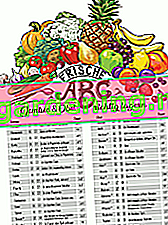
Yeast is often indispensable
When baking, following recipes is important for their success. When yeast is in demand, yeast usually has to be used as well. It is therefore important to have this ingredient on hand at home when needed. But not every household bakes every day. And so it is not uncommon for the yeast to have expired long ago. The freezer could easily have increased its shelf life.
also read
- Yeast, sugar and water for the compost
- Freeze yeast dough - for spontaneous baking without waiting
- This is how yeast activates the processes in the compost
Hardly saves money, but is extremely practical
A cube of yeast is permanently cheap. Saving money does not play a significant role in freezing. Rather, it is about always having the useful properties of yeast available. The freezer offers greater flexibility than the refrigerator, as it extends the shelf life of the yeast many times over.
The following arguments also speak in favor of freezing yeast:
- Food waste is avoided
- A practical supply is quickly created from leftovers
- the extra trip to the supermarket is saved
Freeze whole cubes of yeast
You can selectively buy a few more cubes of yeast and put them in the freezer for later use. You can also freeze whole cubes of yeast that you cannot use up before the expiry date.
The yeast cube can be placed in the freezer in its original packaging. The printed expiration date is a good guide to the storage period.
Freeze yeast residues
It is not uncommon for a recipe to require less than the contents of a cube. Instead of throwing away the rest and buying a new cube for each baking, the one cube can be divided into several baking courses. One part is allowed to do its work immediately, while the rest, wrapped in aluminum foil or stowed in a freezer bag, makes a frosty stopover.
Tips
Weigh pieces of yeast before freezing and write down the number of grams on the freezer bag. So you always know whether the content is sufficient for the selected recipe.
durability
Fresh yeast keeps its driving force in the freezer for six months.
Thawing and Use
Put the frozen yeast in a deep plate and put it in the fridge overnight. The yeast thaws gently in it, but it can also liquefy a little. This does not affect the effectiveness of the yeast.
You can use thawed yeast in the same way as fresh yeast.
For some baked goods, the yeast is dissolved in warm liquids, for example in milk. In such cases, you can use the yeast straight from the freezer without having to thaw it first.
Conclusion for quick readers
- Fresh yeast: is essential for many baking recipes; must therefore be in stock when required
- Freezer: Extends the shelf life of yeast; The driving force is fully retained
- Further advantages: food waste is prevented; Leftovers form a practical stock; saves going to the supermarket
- Whole cubes: Simply put the yeast cubes in the chest with the original packaging
- Yeast residues: wrap in aluminum foil or put in freezer bags and freeze
- Tip: Weigh yeast residues and label accordingly; Content can be compared more easily with recipes
- Shelf life: Fresh yeast can be put in the freezer for six months
- Thawing: Thaw in a deep plate in the refrigerator overnight
- Thawing: Frozen yeast can also be used in warm liquids

The garden journal freshness-ABC
How can fruit and vegetables be stored correctly so that they stay fresh as long as possible?
The garden journal freshness ABC as a poster:
- Order here cheaply as an A3 print for your kitchen
- as a free PDF file to print out yourself








